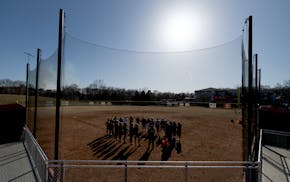Parking on park roads overnight is illegal in Minneapolis. But after residents complained about designs to replace about 25 spots along Uptown's Mall Park with more green space, a sharply divided Park Board recently chose to protect the parking and put its own long-range plans on ice.
The Mall Park is an irregular neighborhood park, comprising five blocks of grassy median and park roads between Hennepin Avenue and Lake of the Isles. The long-range plan for the city's southwest parks — completed in 2020 with extensive community involvement guided by design professionals — called for replacing two blocks of the northern park road with green space and stormwater management.
Two years ago, an opportunity arose to put the plan in motion. The Metropolitan Council announced it was time to replace the old sewer pipes beneath the Mall Park, a $3 million project. Since another agency was coming with money to tear up the street, park staff started preparing for the green space restoration.
Opposition to the loss of parking started simmering as soon as the two agencies began to inform residents about their intent to collaborate. Eventually, the fight assumed aspects of larger culture wars over designing parks for cars, and what the Park Board stands for.
"I don't want to build something or do something that's going to negatively impact the communities that are trying to get around this city," said Commissioner Billy Menz, who proposed the vote to suspend the Mall redesign and restore the roadway following sewer work. "I don't want to damage constituent sentiment towards the Park Board in order to get a short-term goal."
The compromise plan
For months, neighbors showed up to Park Board meetings to demand preservation of parking spots. A Change.org petition with nearly 800 signatures emphasized how precious the spots were to nearby renters.
"Uptown has changed a lot since 2019, with higher crime, stores closing and the permanent removal of parking on local streets," said Lowry Hill resident Craig Wilson at a board meeting last spring. "I've heard from a lot of people, especially renters worried about losing parking and parkway access and threatening to leave."
Wilson served on the community advisory committee that came up with the long-range plan for the Mall Park. He also voted for it six years ago, thinking it was an acceptable compromise between people who initially desired an active park with sports courts and those who wanted a quieter experience and prevailed.
But recently, Wilson told the Minnesota Star Tribune that he is concerned about emergency vehicle access, and that the concept of closing streets was poorly vetted.
Brian Nalezny, an East Harriet resident who chaired the long-range planning committee, disputed that their process was haphazard. He said community representatives and Park Board members spent more time discussing the Mall than other southwest parks, incorporating neighbors' feedback while keeping local ordinances in mind.
"One thing that we constantly heard was that people wanted more area for using the parks, more area for recreation ... so that's what we proposed," Nalezny said. "It's not within the Park Board's mission to provide complimentary parking for non-park uses, and on parkways, you're actually not allowed legally to park on the street overnight."
Fire and traffic safety
Park Board President Cathy Abene and Commissioner Elizabeth Shaffer pushed to pause implementation of the Mall plan, questioning whether fire trucks would be able to reach nearby apartments if streets were closed as planned.
"This is to flush out information that I feel like we, as commissioners, need before we can make a major decision like this," Shaffer said. "And then my plan of action ... would be to follow our policy, and that would be to amend the master plan if we find out information that is of detriment to the public safety of our citizens."
Park staff conducted a traffic study for the Mall Park plan, and reviewed the proposed roadway changes with the city engineer and fire chief.
The traffic and parking study found that local streets had ample space to accommodate parking demand, and the change in area traffic volumes would be relatively minimal.
Minneapolis Fire Chief Bryan Tyner's opinion was that roadways along the southern Mall roadway should maintain continuous flow because of the apartments located there.
However, the two blocks marked for removal under the Mall's long-range plan are located on the northern side of the median, where there are no residential buildings, said Michael Schroeder, park assistant superintendent of planning.
As for the fire code, 20-foot-wide clearance is required for emergency vehicles. Yet the Mall Park's roads include a 12-foot driving lane and an 8-foot parking bay. Complying with the code would mean cutting down trees in the median — a nonstarter for most Park Board commissioners — or removing parking.
Ultimately, Park Board commissioners voted 6-3 last month to restore the Mall roadways to their current condition following the Met Council's sewer work without addressing emergency vehicle access, illegal overnight parking or officially amending the Mall plan.
Amending long-range plans is a deliberate, staff-intensive effort that would cost about $50,000 and delay other projects across the park system, Schroeder said. But not doing so means that when funding becomes available in the future to implement the Mall plan, park staff would still be expected to remove the restored road and replace it with green space at a greater cost.
Commissioner Becky Alper called her colleagues' silence on those issues "hypocrisy."
Commissioners Abene, Menz, Shaffer, Becka Thompson, Charles Rucker and Steffanie Musich voted for restoring the roadway. Alper, Meg Forney and Tom Olsen voted against.
"We are implementing bad governance in just its purest form," Olsen said. "We're ignoring climate issues, we're ignoring our equity-driven matrixes, we're ignoring our overall goals."
Board intervention
Board President Abene won't ask park police to enforce illegal overnight parking, she said in an interview, because people park illegally throughout the park system and, "there are zero 'no-parking signs' on the Mall."
She blamed the long-range planning process for the "chaos" surrounding its implementation, saying that the Mall plan was "infeasible" from the start and that staff failed to do additional review and study of its road closures and alley changes.
"They were directing the closure of the roads. So right there, that should be a big red flag that there's probably some due diligence that needed to happen," she said. "You can't remove the roadway, which is what's shown in the plan."
The Park Board has closed roadways in the past. The Mall's intersection with Hennepin Avenue was closed in 1981 to make way for the new Walker Library. The Park Board closed roads at Victory Memorial Drive about 15 years ago, and it has other long-range plans to vacate other streets, park lawyer Brian Rice said.
While the Park Board's long-range plans are conceptual, all require additional environmental investigation and detailed technical work, obtaining necessary permits and following applicable state laws prior to implementation to understand what the site will allow while maintaining the overall spirit.
Was the Mall plan "unvetted" as its opponents say? Adam Arvidson, park director of strategic planning, said no, because vetting happens at different and increasingly detailed stages of the design process.
"That's true of any design that ever takes place anywhere," he said. "To suggest that any concept plan at that concept level is either completely feasible or completely infeasible is a binary analysis that doesn't exist in the real world."
Sewer work is scheduled to begin next summer. But because the Park Board has discontinued the Mall's park design process, the only role remaining for park staff is to facilitate approvals for the Met Council.

Golden Valley highway crash leaves one man dead; suspect in custody
Semi kills 10 cows on southeastern Minnesota highway
In South Carolina, Walz says Democrats 'need to change the attitude'
Two injured in shooting outside University of Minnesota arena after high school graduation
